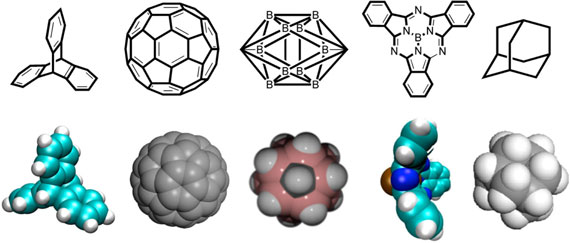| Posted: Jan 15, 2013 | |
Concept nanocars - off to the races? |
|
| (Nanowerk Spotlight) Designing, building, and running molecule-sized nanocars has become an active field of research among nanotechnology scientists. Based on research to reinvent the wheel for nanotechnology, efforts range from the original nano car developed by James Tour at Rice University in 2005 ("Directional Control in Thermally Driven Single-Molecule Nanocars") – which had buckyball wheels and flexible axles, and served as a proof-of-concept for the manufacture of machines at the nanoscale – to 'nanodragsters', and a nano car with molecular 4-wheel drive. | |
| In a new Perspective article in ACS Nano ("Molecule Concept Nanocars: Chassis, Wheels, and Motors?"), Christian Joachim and Gwénaël Rapenne recount how this field began, its growth, and list problems to be solved. | |
| Joachim and Rapenne tell how the first design and synthesis of a molecule-wheeled nanovehicle was the end result of a joke. "During a discussion about the use of the lander molecule concept – a molecule equipped with four legs, used for studying single molecule electronic contact to a metallic step edge – a physicist colleague of ours passed by the meeting room. As the researchers were joking about different possible switchable legs, our dear physicist challenged us to consider substituting wheels instead of legs to create a molecular wheelbarrow. Soon after, the corresponding molecule was designed and synthesized. Then Tour and collaborators proposed and synthesized the first three- and four-wheel molecular nanovehicles." | |
| In the same issue of ACS Nano as this Perspective, Tour's team reports on the Synthesis and Single-Molecule Imaging of Highly Mobile Adamantane-Wheeled Nanocars – the result of intense efforts to deliver better nanovehicles and to approach the grand challenge of synthesizing a single covalent molecule that contains in its chemical structure a chassis, a certain number of wheels and, maybe one day, a motor. | |
| Research on nanocars focuses on two areas: chassis and wheels; and propulsion, i.e. a motor chemical group to power the displacement of the molecular vehicle along its supporting surface. | |
| For the chassis, two strategies have emerged. Researchers are using a polyaromatic hydrocarbon that combines the rigidity of those types of molecules with space for a cargo zone to be able to carry a load (see image below). | |
 |
|
| Examples of molecular nanovehicles. From left to right, the original molecular wheelbarrow, a nanovehicle with triptycene wheels, a nanovehicle with C60 wheels and with four switchable legs instead of wheels. (Reprinted with permission from American Chemical Society) | |
| A second strategy works with a flexible chassis where there is still full control over the distance and position of the wheels along the chassis but with more degrees of freedom leading to more soluble families of molecules. To this end, researchers have already synthesized many different kinds of molecular wheels (see image below). | |
 |
|
| Molecular wheels already used to build molecular nanovehicles. From left to right: triptycene, [60]-fullerene, p-carborane, subphthalocyanine, and adamantane. The chemical structures are shown above and CPK 3D model below. (Reprinted with permission from American Chemical Society) | |
| Another important element of nanocars is their motor. This is the area that researchers still have the most difficulties with. On the drawing board are chemical propulsion from a chemical reaction and tunneling electrons provided by the tip of a STM to create step-by-step rotation of a molecular wheel mounted on a single atom axle. | |
| In what certainly would be a fun event, in order to speed up the synthesis of motorized nanovehicles, Joachim and Rapenne propose a yearly molecule concept nanocar contest to boost molecular nanovehicle research. | |
 By
Michael
Berger
– Michael is author of three books by the Royal Society of Chemistry:
Nano-Society: Pushing the Boundaries of Technology,
Nanotechnology: The Future is Tiny, and
Nanoengineering: The Skills and Tools Making Technology Invisible
Copyright ©
Nanowerk LLC
By
Michael
Berger
– Michael is author of three books by the Royal Society of Chemistry:
Nano-Society: Pushing the Boundaries of Technology,
Nanotechnology: The Future is Tiny, and
Nanoengineering: The Skills and Tools Making Technology Invisible
Copyright ©
Nanowerk LLC
|
|
|
Become a Spotlight guest author! Join our large and growing group of guest contributors. Have you just published a scientific paper or have other exciting developments to share with the nanotechnology community? Here is how to publish on nanowerk.com. |
|
